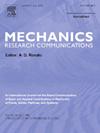Parametric Analysis of Porous FGM Core and CNT Distribution Effects on Vibration Behavior of Truncated Conical Sandwich Shells
IF 2.3
4区 工程技术
Q3 MECHANICS
引用次数: 0
Abstract
This study investigates the free vibration behavior of a three-layer sandwich truncated conical shell featuring a functionally graded porous (FG-porous) core between carbon nanotube (CNT)-reinforced composite face sheets. To model material behavior, five CNT distribution profiles and three porosity patterns—symmetric, non-symmetric, and uniform—are considered. Temperature-dependent material properties are incorporated using established micromechanical relations. The structural modeling is based on first-order shear deformation theory (FSDT), which accounts for transverse shear effects through a correction factor. Governing equations are derived using the energy method in conjunction with Hamilton’s principle. A comprehensive parametric analysis is performed to assess the influence of CNT gradation, porosity distribution, and key geometric parameters such as cone angle, radii, layer thicknesses, and shell length on the vibrational response. Numerical results show that increasing CNT volume fraction and adopting the AV distribution model lead to higher natural frequencies, while increased porosity and core thickness generally reduce them. Boundary conditions also significantly influence the dynamic response. These insights contribute to the design optimization of advanced composite conical structures in aerospace, marine, and mechanical applications.
多孔FGM芯材参数分析及碳纳米管分布对截锥形夹层壳振动特性的影响
本研究研究了碳纳米管(CNT)增强复合材料面片之间具有功能梯度多孔(fg -多孔)核心的三层夹层截锥形壳的自由振动行为。为了模拟材料行为,考虑了五种碳纳米管分布曲线和三种孔隙模式——对称、非对称和均匀。与温度相关的材料特性使用已建立的微观力学关系。结构建模基于一阶剪切变形理论(FSDT),该理论通过修正因子考虑了横向剪切效应。利用能量法结合汉密尔顿原理推导了控制方程。进行了全面的参数分析,以评估碳纳米管级配、孔隙度分布和关键几何参数(如锥角、半径、层厚度和壳长度)对振动响应的影响。数值结果表明,增加碳纳米管体积分数和采用AV分布模型会导致固有频率升高,而增加孔隙度和岩心厚度通常会降低固有频率。边界条件也显著影响动力响应。这些见解有助于航空航天、船舶和机械应用中先进复合锥形结构的设计优化。
本文章由计算机程序翻译,如有差异,请以英文原文为准。
求助全文
约1分钟内获得全文
求助全文
来源期刊
CiteScore
4.10
自引率
4.20%
发文量
114
审稿时长
9 months
期刊介绍:
Mechanics Research Communications publishes, as rapidly as possible, peer-reviewed manuscripts of high standards but restricted length. It aims to provide:
• a fast means of communication
• an exchange of ideas among workers in mechanics
• an effective method of bringing new results quickly to the public
• an informal vehicle for the discussion
• of ideas that may still be in the formative stages
The field of Mechanics will be understood to encompass the behavior of continua, fluids, solids, particles and their mixtures. Submissions must contain a strong, novel contribution to the field of mechanics, and ideally should be focused on current issues in the field involving theoretical, experimental and/or applied research, preferably within the broad expertise encompassed by the Board of Associate Editors. Deviations from these areas should be discussed in advance with the Editor-in-Chief.

 求助内容:
求助内容: 应助结果提醒方式:
应助结果提醒方式:


